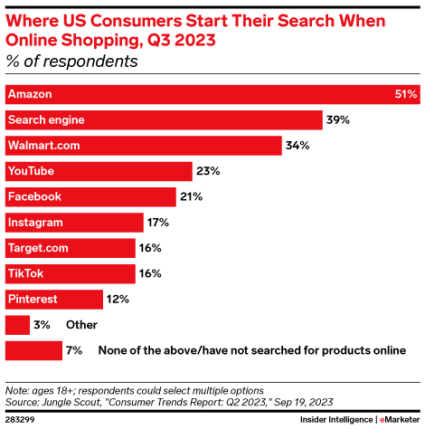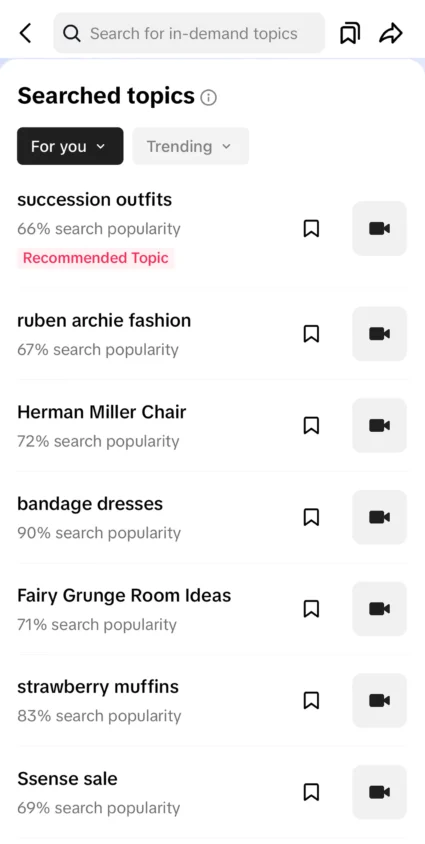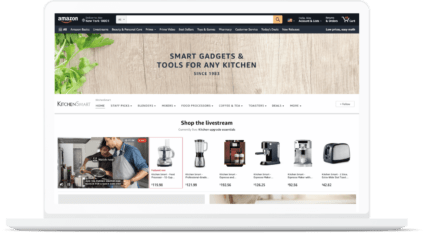Deanna Cullen, Hugh Nelson, and Serena Peterson contributed to this post.
The way we search has changed a lot in the last decade. In the traditional model, marketers would measure success by looking at the number of Google queries. If that number was trending down, it spelled trouble.
Today, the success in search equation isn’t so simple. In addition to search engines like Google, users are searching for information about brands and products on social media platforms and online marketplaces like Amazon, as well as turning to conversational generative AI tools and more.
To get a full picture of your brand’s visibility, you need to understand the role that media convergence is playing in the future of search in particular and across other channels and platforms so you can adapt your strategy to win in this new world.
How today’s consumers are searching differently
As users turn to other platforms besides search engines to answer their queries, a few are emerging as particularly critical. A significant share of search is going to social platforms like YouTube, Reddit, and TikTok, which offer consumers results from accounts run by brands, influencers, and everyday users.
Social search is especially popular among Gen Z; for example, according to a study from Adobe, over 60% of Gen Zers have used TikTok as a search engine, compared to almost half of millennials and a third of Gen Xers. According to eMarketer, 59% of Gen Zers named YouTube as their top choice for search, with TikTok and Instagram taking second and third place.

- Source: eMarketer
When it comes to products in particular, searchers often start their discovery journey on retail media platforms. Amazon dominates this category, with more than half of product searches beginning on Amazon, according to Jungle Scout’s Q3 Consumer Trends Report, while only 39% started on an engine like Google.

- Source: eMarketer
AI is also stealing queries from traditional search engines as consumers increasingly use conversational AIs powered by large language models (LLMs), like Google’s Gemini and OpenAI’s ChatGPT.
That share will likely increase significantly as LLMs get more sophisticated and consumers get more comfortable with the technology. Gartner predicts that search engine volume will drop by 25% by 2026 thanks to AI functions like chatbots.
Changing how you measure success in search
With all of those factors in play, it should come as no surprise that many brands are seeing major downward shifts in search volume on traditional search engines. If we apply the traditional model of evaluating search success, you might see that trend and conclude that it’s the result of brand erosion. But that model is no longer sufficient; in this new reality, a brand may be trending up even if brand search queries are down.
If you’re only looking at SEO, brand search, and direct traffic, you’re missing the big picture. You need better ways of measuring search performance in the modern era.
One particularly common shortcut to evaluating success in search is focusing exclusively on branded search metrics. That approach won’t cut it anymore; most brands are already experiencing a serious decrease in branded search volume on Google. Google explained those decreases by pointing out that non-brand search volume is up and consumers are more often going straight to non-brand search (even if they are already familiar with a brand).
But that’s only part of the story.
To get a better idea of what search volume looks like, brands need to take new sources of search into account, including direct site visits, Amazon brand search, social search, and brand queries to conversational AI. You can’t do that without reports and dashboards that track and stack all sources together so all of the data you need is in one place.
Getting all of that data together can be a challenge; you’ll need to collaborate closely with different teams to make sure all channels are represented appropriately. You can build that single source of truth yourself or get some assistance from a partner, like Wpromote’s Polaris tool, which brings data together from different sources and provides a unified view for tracking and reporting.
When bringing these metrics into one place, remember that data from different channels may not be apples-to-apples with Google search data. You’ll likely need to consider each platform separately, rather than trying to compare metrics directly, to understand how different search sources layer into your brand search volume overall.
Adapting your strategy to a new era of search
Once you have the right measurement solution in place, the next step is to adapt your strategy to include more of the places where people are searching today. If you’re seeing volume from some platforms is on the rise but you’re not actively allocating budget to advertise in those spaces, it’s time to fill that gap.
Users are looking for different things on different platforms, so you should look to diversify your search strategy by focusing on platforms where people are more likely to search for your product and services. For example, Gen Z is more likely to search on social channels for beauty, fashion, and entertainment topics.
Winning on those platforms will require distinct, specific tactics.
1. Social search
Social media has quickly become trusted among consumers as a more visual and engaging search platform. Unlike search engines, which traditionally give search results in the form of links and text descriptions, social media searches give users a more attention-grabbing experience with video and image search results. That means social is a great way to get customers to click and interact with your brand.
Start by logging into the social platforms and actually searching for some things to get a sense of the functionality and what kinds of content are rising to the top. Search on social is about more than direct search results–it’s about getting answers and guidance from trusted creators and communities. This approach will give your brand an opportunity to support discovery and inspiration on the customer journey by prioritizing authentic and engaging content rather than just emphasizing brand messaging. Leverage influencer and creator partnerships to create more interesting content and build a deeper connection with your customers.
As social platforms begin to dabble in search integrations and targeting (and we anticipate some standalone options may be on the horizon), keep in mind that a traditional keyword strategy may not work the same way on social as it does on search engines. Make sure your brand is offering contextually relevant and engaging content like hacks, creator reviews, etc., as well as following top trending searches to gain traction.

Source: TikTok
2. Online marketplace search
You should also be thinking about search on online marketplaces. A large portion of product discovery now starts with retailers rather than on Google or Bing, so if you’re not optimizing your presence on these sites you’re likely missing out on potential customers. Amazon is a major force in this space, so if you sell on the platform, your brand should focus on that marketplace first. First, you need to get the basics right: make sure that your Amazon storefront and product detail pages (PDPs) are updated and optimized so searchers can find your brand easily. But that won’t be enough to truly maximize your presence at the search bar.
Consider leveraging hourly site crawling technology that tracks each placement on the SERP: how often your brand is winning the top-of-search placements, what products and brands you’re competing with for placement, and your share of voice and shelf. You can also use bid management technology to optimize investment across many retailers, which streamlines the buying process vs. buying through multiple platforms. With that tech, you can be very agile in moving investment to maximize placements on the SERP across retailers while also hitting KPIs like ROAS or total sales goals.
For example, if you’re tracking the search query “blender” across Amazon, Target, Walmart, and Costco, you can keep an eye on where your brand is seeing the least amount of competition to win search placements, how that investment is performing, and how healthy inventory is across retailers so you can make informed decisions on where to invest in retail media.

Source: Amazon
3. Conversational AI search
Finally, you should make an effort to optimize your content for the LLMs powering new conversational AI chatbots. While there’s currently no meaningful paid component for advertising on these chatbots, you’ll have a better chance of appearing in organic AI-generated results if you have the right kind of content on your site for the model to pull from.
To optimize your content for conversational AI results, focus on quality and clarity. Write concisely and use structured data (like schema markup) to help LLMs understand the information. Structure your content clearly with headings and short paragraphs, incorporate relevant keywords naturally, and directly answer questions users might ask whenever possible. If your site is producing authentic content that aligns with what your audience is searching for, LLMs can ingest and train on that information to inform conversational responses.
Break down silos between your content, SEO, and PPC teams to get holistic insights into search behavior that will enable more effective budget allocation and a stronger search strategy overall. For example, content teams can benefit from SEO keyword data and PPC teams can leverage insights from LLM results to refine campaigns.
Above all else, remember that today’s search is more than just traditional search engines like Google and Bing; if your brand wants to get customer attention, clicks, and conversions, you need to invest in a holistic strategy that takes all the places users are searching into account. That starts with learning where your target audience is looking for brands and products and building new strategies to get the top spot on those platforms, not just search engines.
Looking to optimize your search strategy for today’s new tech? Download The Game-Changing Power of AI for our experts’ insights on how to make the most of new developments in search.







Responses